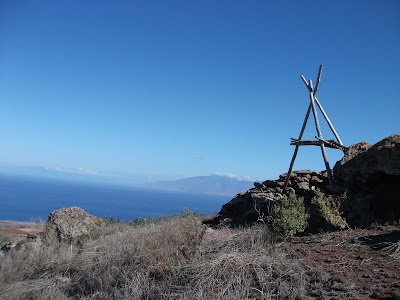 This tiny island has been the target of abuse for the past several centuries, beginning with European contact. Originally, it was known to Hawaiians as the sacred island as the land-form of the god Kanaloa, the god of ocean navigation. The vegetation on the island was classified as a dry forest, which thrived in the winter rainy season.
This tiny island has been the target of abuse for the past several centuries, beginning with European contact. Originally, it was known to Hawaiians as the sacred island as the land-form of the god Kanaloa, the god of ocean navigation. The vegetation on the island was classified as a dry forest, which thrived in the winter rainy season.After European/American contact, this land was then used for ranching. In this process, the herd animals (cattle, goats) demolished almost all of the native species on the island. The land became desolate, and the soil was no longer held in place by vegetation. In the winter rainy months, massive erosion occurs, and thousands of pounds of soil are dumped into the ocean every year.
In the early 1900's, the US Navy then restricted Kaho'olawe for military use, and the island then acted as a place for target practice of new US weaponry. This is how Kaho'olawe became known as the "target isle." Residents of nearby Maui said they would often feel the shaking of the bombings on their neighbor island.
This week marks the 20th anniversary of the end of the bombings on Kaho'olawe. After protests from native Hawaiians, the US government turned the island back over to state control. The government put some funds into cleaning the island of ordinances, but many areas still remain uncleared. The island has been left completely demolished, with soil still pouring into the ocean every winter. The ground that is left is non-nutrient, red deadpan soil, which cannot take new life easily.
For my Hawaiian studies class, we must do one of six service learning projects in Hawai'i. A trip to Kaho'olawe to work with an island restoration group was one of these options. Despite the cost of the trip and the time commitment (4 days of missed class), I decided to go with encouragement from my parents and friends. And I am so glad I did. Even though I'm behind on my schoolwork, going to Kaho'olawe was an incredibly meaningful, once-in-a-lifetime experience.
As a group of about 20 students, we worked with the Kaho'olawe Island Reserve Commission (KIRC) on several projects to restore the land. I was shocked by the landscape-- it looked more like New Mexico desert than any place in Hawaii. (I also discovered the panaramic mode on my new camera...)

The people at KIRC are incredbily friendly and helpful and worked with us to help us understand the history and importance of the island. The number one concern is still runoff of soil into the ocean, and so by planting more vegetation, the ground can possibly be restored to hold water and allow for more vegetation to grow. All planting has to be done on top of the ground, however, because many areas are not cleared of ordinances underneath the ground.
While the obstacles seem countless for getting the land to be revived, there has been so much progress made already. The first day, we were taken up the island and shown the entire landscape. While it did not seem overly fertile, there was some vegetation. We were then told that 95% of that vegetation was only grown in the last 10 years. To think, then, what the land could look like in another 10 years, (or 20 or 30...) made the restoration process seem like a real, feasible goal.


Living on the island for four days was also an incredible experience. We stayed in old military barracks right on the beach. It felt so nice to be staying completely apart from civilization. For two of the three nights, I slept on the soft white-sand beach, underneath a blanket of stars. After working, I bathed in the ocean, replacing the layer of red dirt on my body with a layer of salt. It was good to feel connected to the island and without connection to the outside world.
I can understand why Kaho'olawe is such a sacred place for Hawaiians. I can only hope that restoration continues to a point where anyone can go and visit and learn about the history of this sacred place...
And now for some pictures I didn't know how to fit into the post...
On the last day, we went up to Maulaiki, which used to be a major point of navigation for Hawaiians as it is one of the highest points on the island. From here, we could see 3-4 of the other islands around us.

 Me at the top:
Me at the top: This was quite possibly the most gorgeous sunset I had ever seen. And I watched it from my hammock:
This was quite possibly the most gorgeous sunset I had ever seen. And I watched it from my hammock:

What a moving account of your incredible experience, Maya. Your passion for the land and the work you did shines through. I hope that you will be able to return in years to come and feel proud of the part you played in restoring the island to health. Love, Your proud momma
ReplyDelete